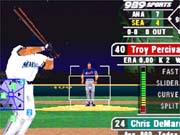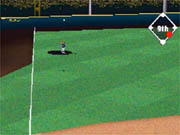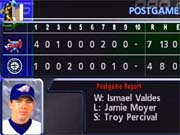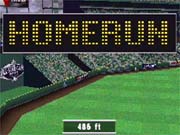Baseball's 2001 season is already a month old, but like a power hitter fresh off the disabled list, Sony's MLB 2002 is already swinging for the PlayStation's fences. At first, this latest installment in the MLB series feels like a carbon copy of last year's release. However, closer inspection reveals many minor enhancements and additions that should prove pleasing to both series veterans and newcomers alike.
Graphically, not much has changed. MLB 2002 remains a colorful, crisp, and well animated rendition of 3D baseball. The amount of detail is nowhere near that of EA's Triple Play, but the polygons saved by using simpler field textures allows for greater realism in player movement. If you're familiar with things like Tony Gwynn's cumbersome base running or the cheetahlike throws of Andruw Jones, or you enjoy games where the pitcher ducks when the batter hits a line drive, you'll like what you see here. Minute accoutrements, such as animated diamond-vision displays and updating scoreboards, continue to be the highlight of MLB 2002's non-player eye candy.

MLB 2002 also sounds just about the same as MLB 2001--with one huge, huge difference. Vin Scully's play-by-play and Dave Campbell's color commentary are both much smoother this year. In particular, Scully's repertoire mixes and mingles a greater diversity of player names and colloquialisms, resulting in such phrases as "Erstad tripled last time up" and "At the plate, Adam Kennedy. He struck out in his last at bat." Once again, Campbell plays the sidekick to Scully's deadpan, a situation that creates a faked television-style experience--even if Campbell's prattle is just as painfully mind-numbing as it is on real TV.
The fact that MLB 2002 isn't much different from last year's release in terms of graphics and sound isn't too terrible. While more detail in the stands would have been nice, baseball is still mainly a game of strategy and statistics. To that end, MLB 2002 is definitely geared toward the "sim" crowd of video game baseball fans. The mode screen includes a plethora of fantasy baseball mainstays, including exhibition, season, all-star, playoff, spring training, and home run derby game options. Once again, MLB 2002's spring training mode isn't just a six-game foray into tiny cornfields, but a career-building experience in which you'll hopefully lift a rookie player from the depths of the minors into the glory of "the show." Along the way, should you collect enough points that is, you may find yourself voted into the All-Star Game or earning bonuses for a variety of awards, including the Rolaids Relief Man, Player of the Week, and MVP honors. In all, the game includes more than 900 different athletes drawn from all 30 MLB teams and their minor league affiliates.

Fleshing things out, MLB 2002 also boasts an intense combination of general manager and franchise modes. These range from the usual gamut of player creation, draft, and trading options to such giddy niceties as total league realignment and farm system call-ups. Rosters are only current as of March, unfortunately, but a trip to the GM mode will send Rickey Henderson to the Padres and put the Yankees' Chuck Knoblauch into the outfield where he belongs. Stat heads will definitely adore this year's redesigned player cards screen, which not only gives you the portrait and vital statistics of each player, but also offers statistical breakdowns in more than 90 categories, complete with charts and graphs.
Gameplay is the area where the differences between MLB 2002 and last year's MLB 2001 really become apparent. MLB 2002 still plays a smart, responsive, and mean game of baseball, but CPU opponents are much less infallible than in previous years. However, CPU opponents are even better at the plate and will rarely swing at pitches outside the zone, let alone anything wild. It also seems like the percentage of home runs and fly balls has significantly increased, but the inclusion of the newly updated strike zone offsets this adjustment at least slightly. Although the onscreen pitching frame reflects the traditionally accepted strike zone, pitching high or outside a few times quickly reveals the truth of the matter--the high strike is here and it means business. Subjectively, the CPU AI is still a bit too difficult, but some players will no doubt revel in the resulting challenge.

One of the wildest changes in MLB 2002 has to do with the players themselves. They all have a physical presence on the field, meaning that friend or foe alike can collide with one another. Not only does this make for some fun times in the outfield, but it also makes charging into home plate a brutally enjoyable work of art. If you foresee a close play at the plate, let your player crash into the catcher and you might knock the ball out of his glove, which usually sends it hurtling toward the backstop.
As for control, MLB 2002 offers many levels of batting, pitching, and fielding complexity. For arcade lovers, the game's batting and pitching interfaces can be minimized such that pitch choice and swing timing are the only variables you need to worry about during an at bat. 989 Studios has even included an automatic-fielding choice for those who dislike chasing down groundball after groundball. However, if you like your baseball complex, MLB 2002 can bring it with the best of them.
The total control interface from MLB 2001 has evolved for MLB 2002. You select your pitches via a menu that provides a choice of four key pitches per player, with location designated by an onscreen cursor. Pitch speed is also an adjustable variable this year. There's still a response delay between the input of the command and the pitcher's wind up, but it's not a huge issue. As far as the defense sitting behind the pitcher, fielding is unchanged from MLB 2001, with one notable exception. You can now just press the L2 button to automatically perform snappy dives and superstar grabs when your player nears the ball.

Compared with pitching and fielding, batting has gone through an even wider array of tweaks. For better or worse, the overall batting interface looks like the targeting system of an F-16 jet. A large white box shows the area your swing will encompass, while a set of crosshairs in the middle denotes the sweet spot of the bat. When the pitcher releases the ball, a red box will appear in the strike zone based on the pitch's trajectory. Your job is to line up your box with the pitcher's. Within the red box, a little yellow box represents the ball itself as it nears the plate. If your crosshairs are dead center, you'll hit a line drive. If not, you may end up hitting a grounder, a foul tip, a pop up, or a home run, or you may just whiff altogether. "Total Control" guessing adds even more flavor to the equation. By pressing L2, you can pause the action and guess where the pitcher will throw the ball and what pitch he'll use. If you're correct, your batting area will increase. You can also toggle between hit-for-power and hit-for-average swing settings with a press of the X button.
Considering the above paragraphs, it's little wonder why people complain that the MLB series overcomplicates baseball video games. However, it's important to note that all the game's simulation options are just that, optional. Depending on the settings you select, you will experience either a wild arcade romp or a die-hard foray into reality.
More annoying than the morass of interface options, games in MLB 2002 still take far too long to complete. Although it's possible to bypass mid-inning transitions, home run trots and pre-pitch gestures cannot be skipped. For some, this will create pacing faithful to the cadence of real baseball, but 60 minutes per game is a bit much to ask.
If you can get past the sluggish pacing and incessant overcomplication, MLB 2002 is a wonderful game. Veterans may find that the changes and improvements in this latest release don't prevent it from evoking a deep feeling of déjà vu, but the additional gameplay modes, statistics options, and interface changes should be enough to warrant its purchase.